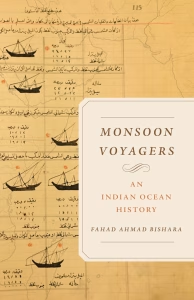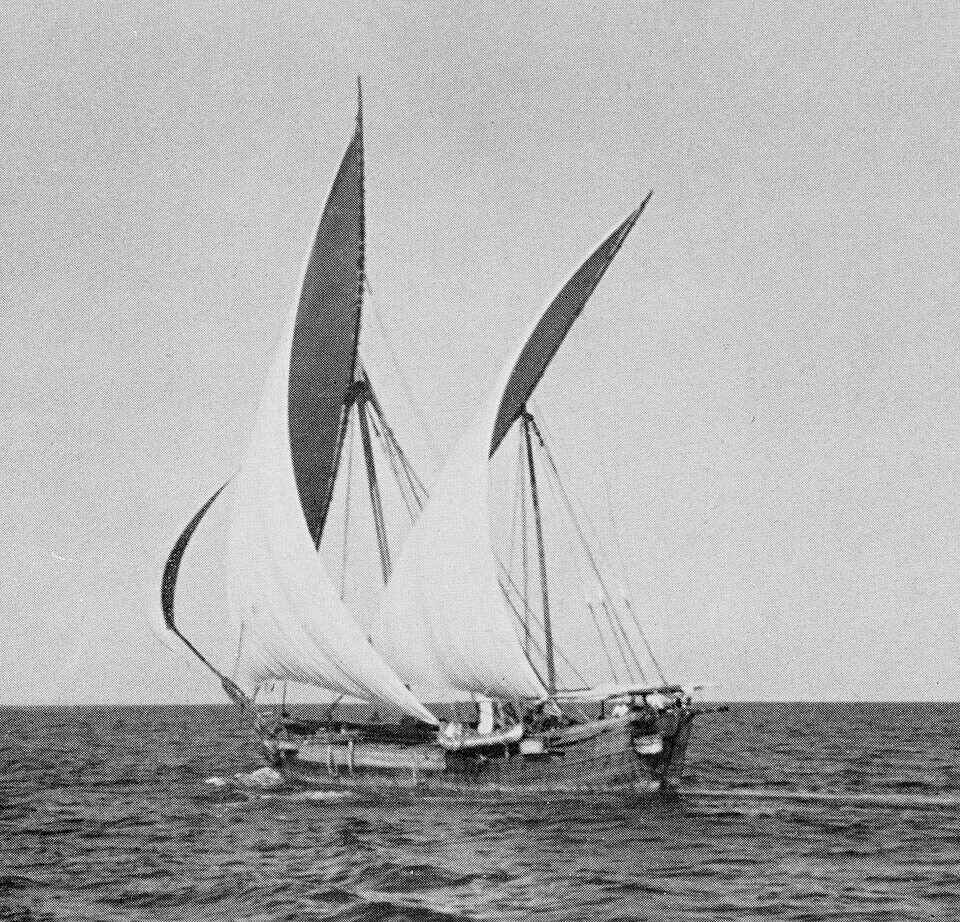Our beliefs about the past pass through filters both ideological and physical. Cotton, leather and papyrus all disintegrate with time, but fired clay does not. Hence museums filled with jugs and bowls instead of scrolls and clothing. Still, such a vessel inspired one of England’s most celebrated poems, John Keat’s “Ode on a Grecian Urn”. It seems that Fahad Bishara had a similar epiphany when he beheld a century-old ship’s logbook, or ruznamah. Although written in prose, Monsoon Voyagers evokes Keats by bringing a lost world to life, combining a scholar’s rigor with a poet’s voice.
From the deck of a dhow in 1924, the book explores an “oceanic society” of Kuwaiti merchants scattered across the Western Indian Ocean under British suzerainty. Much of Bishara’s writing is literally sensuous. Readers hear sangani, a song of lamentation, as the ship leaves its home port, then the ouds and tambourines setting the tempo for onboard dancing, and finally the soft chanties hummed by sailors going about their work. They smell the cloves and cardamon wafting through a coffeeshop in Muscat, not quite strong enough to cover the human waste and gutted fish littering the nearby beach. Be sure to keep an eye out for landmarks, from date palm plantations lining the Shatt al-Arab to the ancient Dwarkadhish temple on Kathiawar peninsula. Readers will feel the coir rope forming calluses on their hands, but find relief by coating the hull with shūnah, a compound of limestone and animal fat.
This particular ship, Al-A‘waj, the Crooked, had a capacity of 225 tons and a crew of 30. Bishara explains every role: the captain, or nakhoda, negotiating the distribution of profits with the dhow’s owner and deciding which goods to sell in what port, assisted by his first mate who assembled the crew and allocated work at sea. Every position required physical fortitude and specialized knowledge, be it deckhand, helmsman, navigator, or carpenter. While their contemporaries in the Royal Navy suffered under the lash, the Crooked maintained discipline through a ubiquitous web of credit, tying dhow owners to their captains, captains to their crew, traders to farmers, banks to merchants, and rulers to their elite. No surprise then, that the first page of the captain’s logbook contained two template contracts.
Bishara reveals a community that transcended the neat geographic units shown on today’s maps.

Fahad Ahmad Bishara (California University Press, October 2025)
That ruznamah often feels like the book’s real protagonist. While port calls entailed the transmission of telegraph messages, a dhow at sea was still utterly alone in 1924, making the information physically on board vital. Hence a logbook thick with legal documents, accounting records, and formulas for the conversion of weights, measures, currencies, and calendars. While the ship kept the coast in sight, they also kept third-hand British maps on board, heavily annotated with Arabic notes. Among these workaday files belonging to captain ’Abdulmajeed Al-Failakawi, Bishara noted a second, more refined handwriting, written by Manur Al-Khariji, an elder nakhoda and Al-Failakawi’s father-in-law.
From underneath a veritable raft of primary documents, Bishara reveals a community that transcended the neat geographic units shown on today’s maps. The book’s most salient relationship was between nakhoda Al-Failawaki and Muhammed Shaheen Al-Ghanim, owner of the dhow. Al-Failawaki knew to keep a strict accounting of the ship’s expenditures, just as Al-Ghanim appreciated that a long-term return on his ship required a reliable and committed captain. They both relied on a dense network of Kuwaiti bankers, wholesalers, and distributors across the Indian Ocean. Men like Muhammad al-Matrook, a date merchant in Basra who correspond in Arabic, Persian, Gujarati, and English. Or Muhammad al-Sudairawi, a financial impresario facilitating checks, payments, and deposits across a dozen banks from his office in Bombay. Then as now, competitive advantage depended on access to information, and that information required membership in a network defined by trust.
That close-knit Kuwaiti diaspora facilitated the distribution of goods throughout the region. The rewards were ample, but success demanded attention to detail. To turn a profit buying dates in Iraq for sale in Karachi, one had to anticipate the relative demand for its sāyer, khaḍrāwi and zāhadi varieties, while also making sure the ideal ripeness would coincide with the expected delivery date. Upon selling the dates, the same calculus occurred for the return journey carrying different grades of ḥinṭa (wheat) and ṭaḥīn (flour). The pearl trade required so much esoteric knowledge that brokers carried manuals for reference. The Arab shipwrights who built the Crooked itself had to distinguish between three varieties of timber and eight of coir, all from Malabar. Of course, this assumes the ship arrived at its intended destination on time; that called for the daily application of trigonometry to observations made by a sextant. To Bishara’s credit, these many details never feel pedantic. Rather, they evidence the acumen possessed by men like Al-Failakawi.
Perhaps because his own grandfather captained a dhow, Bishara describes this world as the sailors and merchants saw it. The Crooked cast anchor in Bombay and Calicut, not Mumbai or Kozhikode. The nakhoda were practical men, not overly troubled by practices like slavery, then still common both at sea and among pearl divers closer to shore. Likewise, the British Empire seemed to be a going concern, sovereign over every stop along the Crooked’s journey.
Al-Failakawi gave no thought to Karl Marx, and neither does this book; descriptions of the debt and labour agreements on ship stick to the documents. Bishara’s refusal to stray beyond the evidence speaks to his respect for both his ancestors and the historian’s craft.
By the book’s close, Al-Failakawi appears more nuanced and authentic than many literary characters.
With their knowledge of the ensuing century, readers may see the Crooked’s journey in poignant terms; the final act before history brought down the curtain on the age of sail. After all, Bahrain signed its first oil concession mere months after the ship weighed anchor for Kuwait. Al-Failakawi himself went on to pilot oil ships, while boats like the Crooked would ply the Gulf for decades after being retrofitted with outboard motors. But the logbook makes clear that the world did not change overnight; after a few months with his family, Al-Failakawi returned to the sea in 1925, more focused on his sextant and the price of dates than history’s tectonic shifts.
By the book’s close, Al-Failakawi appears more nuanced and authentic than many literary characters. Perhaps the book’s real thesis is that more historians should refrain from making individuals emblematic of an age, and instead accurately render ordinary men devoted to their work and family. They would do well to emulate Monsoon Voyagers, a book that reiterates what Keats said in 1819: “Beauty is truth, truth beauty, —that is all Ye know on earth, and all ye need to know.”


You must be logged in to post a comment.